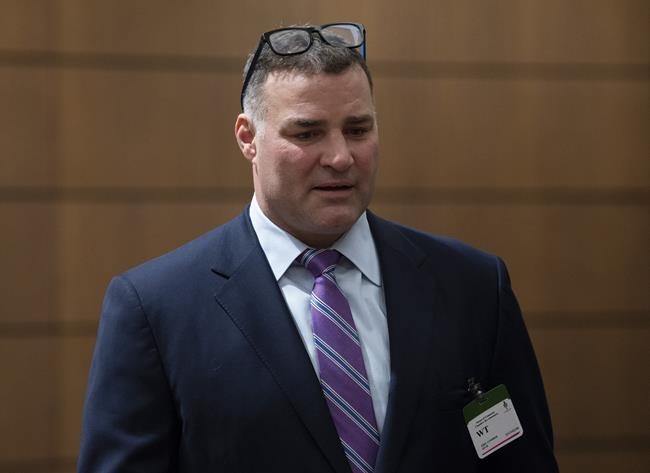TORONTO — Eric Lindros remembers looking at the Penguins logo on his towel and feeling confused.
A powerful, hulking, skilled centre for the Philadelphia Flyers, he'd taken a big hit from feared Pittsburgh defenceman Darius Kasparaitis earlier that afternoon in a game between the Pennsylvania rivals.
Lindros didn't understand it fully at the time, but the collision had left him concussed.
"He tuned me really well," he recalled. "I got into the showers, and when you're in the visiting team's locker room, all the emblems on the towels have the home team's logo. I truly thought I got traded to Pittsburgh.
"I joke about it now. I thought I was getting a chance to play with Mario Lemieux, but that moment was bad ... it was bad."
Years later, after his Hall of Fame career was cut short by repeated blows to the head, Lindros is hoping a new campaign launched across Ontario will help amateur athletes, parents and coaches avoid similar experiences by assisting them to better identify the signs and symptoms of a concussion.
"You see anything that's off or someone's not feeling quite right, let's pull them (out of the game)," Lindros said in an interview with The Canadian Press on Tuesday. "Let's not even question it."
The provincial government's ad campaign — entitled "Hit. Stop. Sit." — follows on the heels of the passing of Rowan's Law, the first of its kind in Canada and set to come on the books beginning July 1.
The law is named after Rowan Stringer, a youth rugby player who died in 2013 from second impact syndrome after suffering multiple concussions in a condensed timeframe.
Rowan's Law establishes protocols for players to ensure they're taken out of action if a concussion is suspected, requires a review of awareness resources and outlines a code of conduct that sets out rules of behaviour.
"We're here because Rowan pushed it," Lindros continued. "She had three concussions in six days — that's an extreme case — and she ended up dying. We don't want anything close to that happening."
A jarring commercial featuring a female soccer player receiving repeated blows to the head before collapsing on the field has been shown at movie theatres across Ontario as part of the campaign. The spot made its TV debut during Monday's Game 5 of the NBA Finals.
An imposing mountain of a man at six foot four and 230 pounds during his playing days, Lindros said getting everyone on board, especially when decisions need to be made in the heat of the moment, won't be easy, but added it's what has to happen.
"We want everyone to buy in," said the 46-year-old father of three. "Parents are going to protect their kids. Let's look out for your kid's teammates.
"Let's go a step further and look out for the opposition."
Lindros testified before a special House of Commons committee looking into what, if anything, the federal government should do about sports-related head injuries back in February. He wants to see a single national concussion protocol based on Rowan's Law.
"You always get a better message across when it's one brand," Lindros said. "Look at Amber Alerts. Everyone knows it means there's a missing kid.
"It would be great if in time if you say 'Rowan' you think 'concussion.'"
Lindros, who doesn't want the threat of concussions to deter kids from playing sports, also favours a ban on all hits to the head across hockey — including the NHL — and the teaching of body contact at a much later age than the current standard.
He's focused his attention on amateur athletes, but when Lindros testified in Ottawa, the No. 1 pick in the 1991 NHL draft said the government shouldn't even bother trying to work with professional leagues because money muddies the waters.
NHL commissioner Gary Bettman has consistently questioned any direct link between multiple concussions and chronic traumatic encephalopathy (CTE) — a brain condition associated with repeated blows to the head.
"I don't believe there has been, based on everything I've been told — and if anybody has information to the contrary, we'd be happy to hear it — other than some anecdotal evidence, there has not been that conclusive link," Bettman told the committee on Parliament Hill on May 1.
The symptoms of CTE, which can only be diagnosed after death, include memory problems, personality changes, aggression and depression.
"I wish I would have known," Lindros said of the dangers of concussions. "I would have toned it down quite a bit, for sure."
He also let out a sigh when asked about Bettman's concussion and CTE comments.
"I don't understand how the NFL can change their tune and speak to CTE in a far different fashion now than in the past, and it not be acknowledged by our guys," said Lindros, who also played for the New York Rangers, Toronto Maple Leafs and Dallas Stars. "There are some owners that really want to get ahead of this, get in front of it, support it, and maybe this will happen.
"I'd really like to think so."
But for now, Lindros is working to help amateur athletes, parents and coaches across Ontario identify and deal with concussions.
"Things have improved over the last 10 years," he said. "But we've got a long way to go."
___
Follow @JClipperton_CP on Twitter
Joshua Clipperton, The Canadian Press




